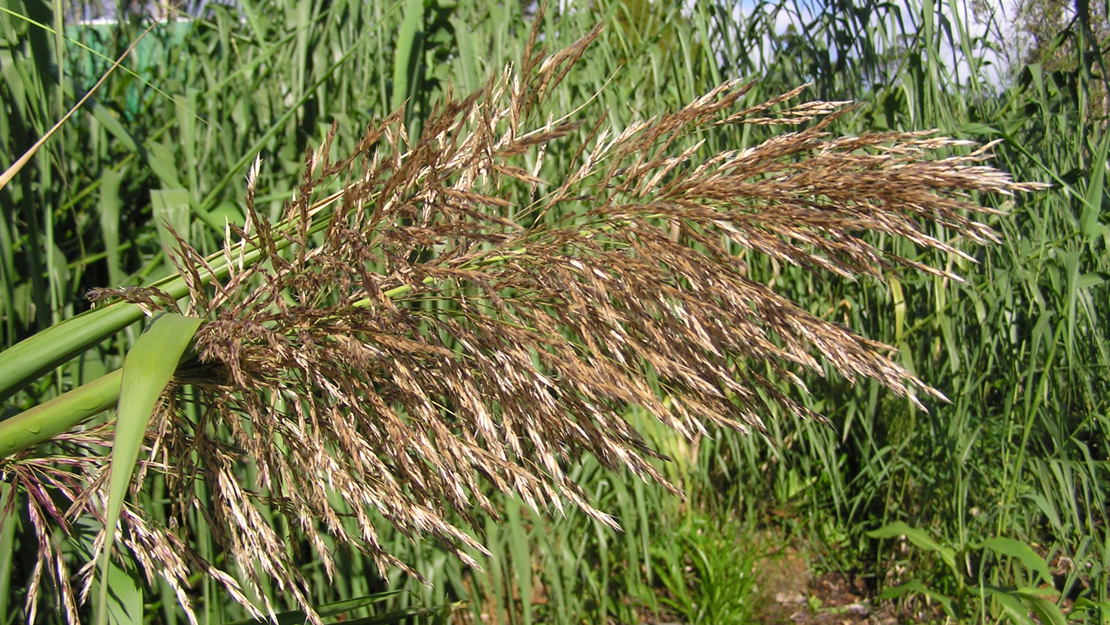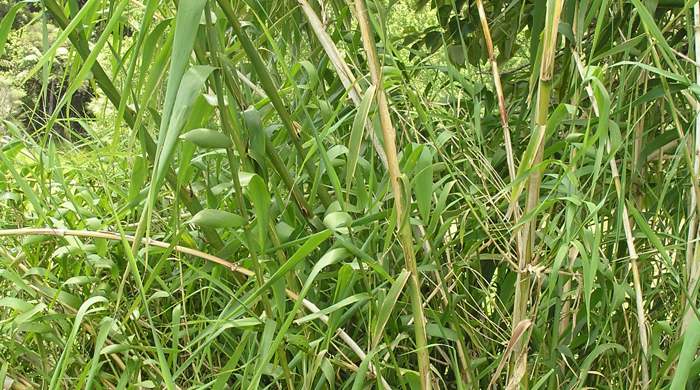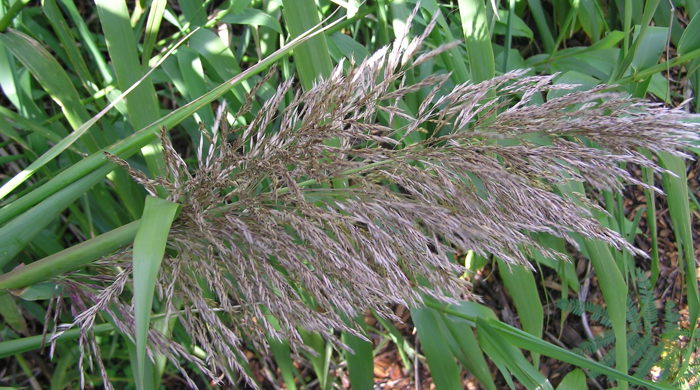Arundo donax
Giant reed
Also known as:
Bamboo reed, donax cane, arundo grass, cow cane, river cane, reed grass
Family: Poaceae
Origin: Eurasia

Regional Pest Management Plan (RPMP) status
- Aotea — Eradication
- Whole region — Sustained control
- Waitākere Ranges Heritage Area priority status
- National Pest Plant Accord Species
- Parkland with Significant Ecological Areas — Site-led (on-park and buffer)
General description
Sturdy, perennial, bamboo-like grass. Rhizomes are thick, lumpy and spread in continuous clumps < 1 m thick. Stems are spreading, clumping and < 6 m tall. Leaves are maize-like, sharp-edged, < 60 x 5 cm and opposite. Flowers are borne in large, fluffy, purplish turning to silver inflorescences.
What you need to know
To help protect our environment:
- You must not breed, distribute, release or sell giant reed. As giant reed is a National Pest Plant Accord species, these restrictions apply within the Auckland region and across the whole of New Zealand.
- You must not plant giant reed within the Auckland region.
- You must destroy any giant reed on land that you occupy if it has been planted in breach of the above rules and you are directed to do so by an authorised person.
Auckland Council will control giant reed at all sites within the Aotea/Great Barrier Island group where it is known to occur.
If you see giant reed anywhere on Aotea/Great Barrier Island group, please report it to Auckland Council at pestfree@aucklandcouncil.govt.nz.
Auckland Council will manage giant reed in buffer areas of parks, where giant reed is being managed, to an extent that protects the values of that parkland. If you wish to help protect your local parkland, you are encouraged to control or remove any giant reed on your land and plant a better alternative instead.
View a map of park buffers.
To find out more about how we’re protecting Auckland’s parkland from pest plants, visit our pest plant buffer pages.
Habitats
Riparian and forest margins, wetlands, saltmarshes, gullies, dunes, roadsides.
Dispersal
Seeds dispersed by wind. Vegetative spread from rhizomes, rhizome fragments and stem layering.
Impact on environment
Forms dense stands and displaces native vegetation. Alters hydrology by blocking water flow. Impedes drainage and exacerbates flooding in agricultural systems.
Control
Site Management
Follow up treated areas 3 times per year. Encourage natural regeneration of native plants or replant treated areas where possible after 2-3 treatments to establish dense ground cover and minimise reinvasion.
Recommended approaches
Do not attempt to undertake control of this species on Aotea/Great Barrier Island group. Please report to Auckland Council if seen on Aotea/Great Barrier Island group.
Physical control
Method: cut stems and dig out rhizomes.
Plant parts requiring disposal: Rhizomes and roots.
Disposal options: Stem cannot be chipped and used as mulch as it can regrow or remove to landfill.
Biocontrol
Check for the presence of agents:
For more information about how biocontrol works, see What is biocontrol?
Community agrichemical control recommendations
No qualifications:
For small infestations: Cut stump and paste freshly cut base of stems with double strength glyphosate gel, cut stump and spray freshly cut base of stems with 250ml glyphosate green per 1L of water or cut stump and foliar spray regrowth with 150ml glyphosate green per 10L of water.
Stems can be stacked in piles and foliar sprayed or removed to landfill.
Certified Handler/Experienced agrichemical user:
For large infestations amongst desirable broadleaf species: Cut stump and foliar spray regrowth with 150ml haloxyfop-P-methyl per 10L of water.
For infestations amongst desirable species: Cut stump and very carefully foliar spray regrowth with 150ml glyphosate green per 10L of water avoiding any spraying on desirable species foliage.
Stems can be stacked in piles and foliar sprayed or removed to landfill.
Caution: When using any herbicide or pesticide please read the label thoroughly to ensure that all instructions and safety requirements are followed.





